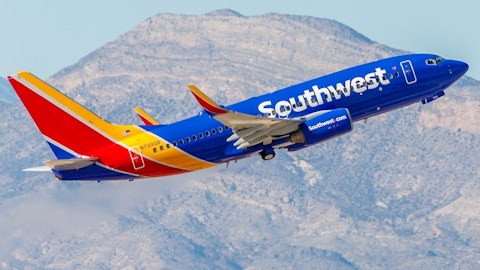Jamie Baker: Okay. Perfect. I appreciate the color. And then on oneworld, you said reaching 10% of group revenue by 2025. That’s the goal you gave, right?
Shane Tackett: 8% to 10%. Okay.
Jamie Baker: 8% to 10%, okay. So I’ve always assumed that connecting revenue or alliance revenue is less profitable than local revenue Obviously, if the connecting revenue is entirely incremental, it’s highly accretive. I know — and maybe my assumption is flawed. I know you’ve been really bulled up on your one rolled membership. But on a margin basis, how does that 8% to 10% compared to your core flying.
Andrew Harrison: Well, I think — so a couple of things. And again, just what we’ve seen this year, especially with American Airlines and not just international but domestically, connecting over their hubs and even some local market code share we have. We participated in American strong revenue environment as well where their corporate travelers or leisure travelers or connecting beyond need to utilize our network to help make for a better, shorter trip. So overall, I’ve been very happy with the yields that are being produced. And again, as we go into this year with international travel and the proration of the strong international fares, again, from what we had last year, I think these are all positive momentum for us.
Operator: And our next question will come from Catherine O’Brien with Goldman Sachs.
Catherine O’Brien: So in December, you guys have some really unusual weather that drove the operational issues you saw not being that preparing for an ice storm on Christmas should be the operational base case, but some of your peers are talking about the need to have permanently higher buffers to protect the operation. Do you believe that you already had the appropriate buffers in place for 8% to 10% capacity guide for 2023 and December didn’t really to change anything. Some color there would be great
Shane Tackett: Maybe I’ll just speak to ’23, and you can speak to the December event. By the way, welcome back, Catie, it’s good to hear from you. I think we do have sufficient buffers in our capacity plan and our staffing plan to ensure that we’re not overstressing the network. If you look at the second half of the year, once we sorted out our April issues with pilot training, we were amongst the best in the industry on both on time and completion rate. Yes, this was a — although it’s becoming the norm because it happened last year as well. This was a pretty unique event that lasted multiple days and did ice over our aircraft here in Seattle and in Portland and actually in other parts of the Pacific Northwest. So it was a pretty unique event. And I think it’s probably not — we’re not going to assume that it happens to us every single year, but we do have to build some more resilient irregular ops for sure.
Benito Minicucci: Yes, Catie, it’s Ben. Having done operations in my whole career, I mean you can look at it a couple of ways. You can create a massive amount of buffer for an event that might not happen or you can go in with the appropriate level of staffing with some additional cushion to deal with winter events. But things like ice storms are massive events that cripple a city, and there’s not a lot you can do no matter how much buffer you put in, there’s nothing you can do to operate in an ice storm. So what our mindset is create a robust schedule that we can operate in the peak periods or peak periods where there’s — where we’re susceptible to weather, create additional buffers but it’s got to be managed appropriately. So we were good. This was just a big event, and I’m pretty proud of the team and how we dug out of it and got back on track.




